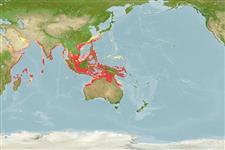Environment: milieu / climate zone / depth range / distribution range
Ecologie
marien demersaal; diepte 1 - 100 m (Ref. 9792), usually 20 - 50 m (Ref. 9792). Tropical; 26°N - 21°S, 43°E - 156°E (Ref. 54739)
Indo-West Pacific: Red Sea and East Africa to Japan and Australia.
Lengte bij maturiteit / Grootte / Gewicht / Leeftijd
Maturity: Lm 38.0, range 37 - 39 cm
Max length : 64.0 cm TL mannelijk / geslacht onbekend; (Ref. 6006); common length : 50.0 cm TL mannelijk / geslacht onbekend; (Ref. 5450); max. gepubliceerd gewicht: 9.0 kg (Ref. 1468)
Dorsale stekels (totaal): 9 - 11; Dorsale zachte stralen (totaal): 38-45; Anale stekels 1; Anale zachte stralen: 33 - 43; Wervels: 23 - 25. Body oval and flat, but thicker than in most other flatfishes. Mouth large with strong teeth; maxillary extends well beyond hind edge of lower eye; both eyes on left or right side; upper eye lying immediately below dorsal edge; gill rakers not developed. Dorsal fin origin well posterior to eyes; anterior fin rays spinous; lateral line almost straight. Color usually brown or grey, sometimes with 4 broad, dark crossbars. Dorsal, anal and caudal fin tips black. Blind side occasionally partially colored. (Other sources of morphological data: Refs. 591, 529, 4416, 5997 and 6000).
Found on sand and mud bottoms (Ref. 9796, 48637). Usually deeply burried in the substrate during the day, but out and hunting at night (Ref. 48637). Often swims in an upright position (Ref. 9796). Mainly piscivorous (Ref. 5986). Mainly sold fresh (Ref. 5213); also utilized smoked and frozen (Ref. 9987). Processed into fish flour (Ref. 6040).
Studies in Porto Novo, India (Refs. 5993 & 5997) show that the sex ratio significantly differ from 1:1, but the reports are ambiguous as to which sex predominates.
Nielsen, J.G., 1984. Psettodidae. In W. Fischer and G. Bianchi (eds.) FAO species identification sheets for fishery purposes. Western Indian Ocean fishing area 51. Vol. 3. (Ref. 3485)
Status op de Rode Lijst van het IUCN (Ref. 130435)
Gevaar voor de mens
Harmless
Gebruik door de mens
Visserij: commercieel
Tools
Speciale rapporten
Download XML
Internetbronnen
Estimates based on models
Preferred temperature (Ref.
123201): 26.6 - 29.1, mean 28.2 °C (based on 1198 cells).
Fylogenetische diversiteitsindex (Ref.
82804): PD
50 = 0.7500 [Uniqueness, from 0.5 = low to 2.0 = high].
Bayesian length-weight: a=0.00676 (0.00507 - 0.00901), b=3.14 (3.06 - 3.22), in cm total length, based on LWR estimates for this species (Ref.
93245).
Trofisch niveau (Ref.
69278): 4.4 ±0.3 se; based on diet studies.
Weerstandsvermogen (Ref.
120179): Gemiddeld, minimale populatieverdubbelingstijd 1,4-4,4 jaar (K=0.26-0.5; tm=3-4; Fec=300,000).
Prior r = 0.74, 95% CL = 0.49 - 1.11, Based on 3 stock assessments.
Fishing Vulnerability (Ref.
59153): Low to moderate vulnerability (29 of 100).
Climate Vulnerability (Ref.
125649): High to very high vulnerability (68 of 100).
Nutrients (Ref.
124155): Calcium = 122 [62, 249] mg/100g; Iron = 1.15 [0.54, 2.15] mg/100g; Protein = 18.4 [16.9, 19.9] %; Omega3 = 0.181 [0.080, 0.383] g/100g; Selenium = 68 [30, 151] μg/100g; VitaminA = 20.1 [6.2, 65.2] μg/100g; Zinc = 0.728 [0.470, 1.071] mg/100g (wet weight);
